Compared to Beijing Auto Show and Shanghai Auto Show, the scale, volume, and number of new car releases at Guangzhou Auto Show are much smaller. But this year’s Guangzhou Auto Show has made us very excited. Why? The debut of several cars at this auto show shows that in the wave of the global automotive industry’s collective transformation to electrification and intelligence, Chinese companies have already taken the lead.
Take, for example, the BYD Tang EV 600.
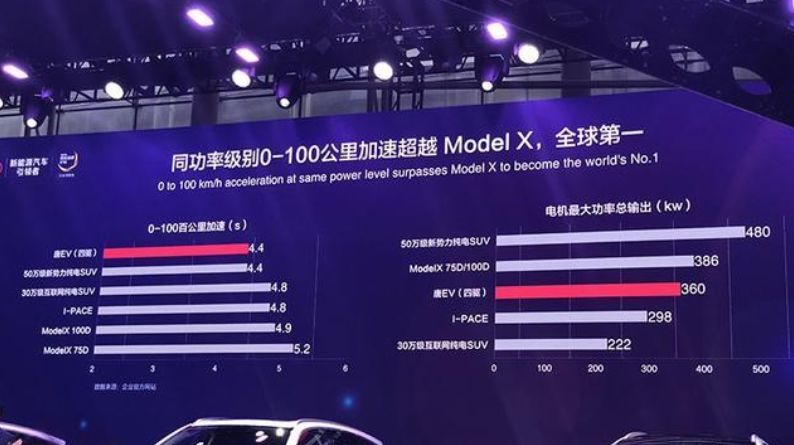
The official data in the PPT is very eye-catching. So what is its real level? Here are the basic parameters of the BYD Tang.
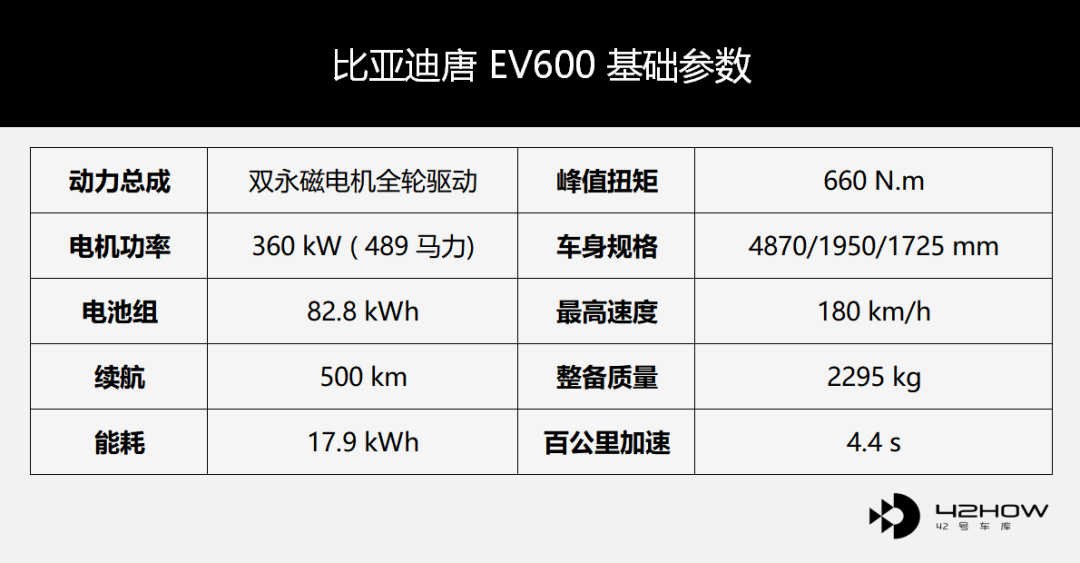
The total power of the dual motors is 360 kW, the battery pack capacity is 82.8 kWh, the 0-100 km/h acceleration is 4.4 seconds, and the range is 500 kilometers… Intuitively, it’s very strong! So how strong is it? Here are the basic parameters of the Mercedes-Benz EQC.
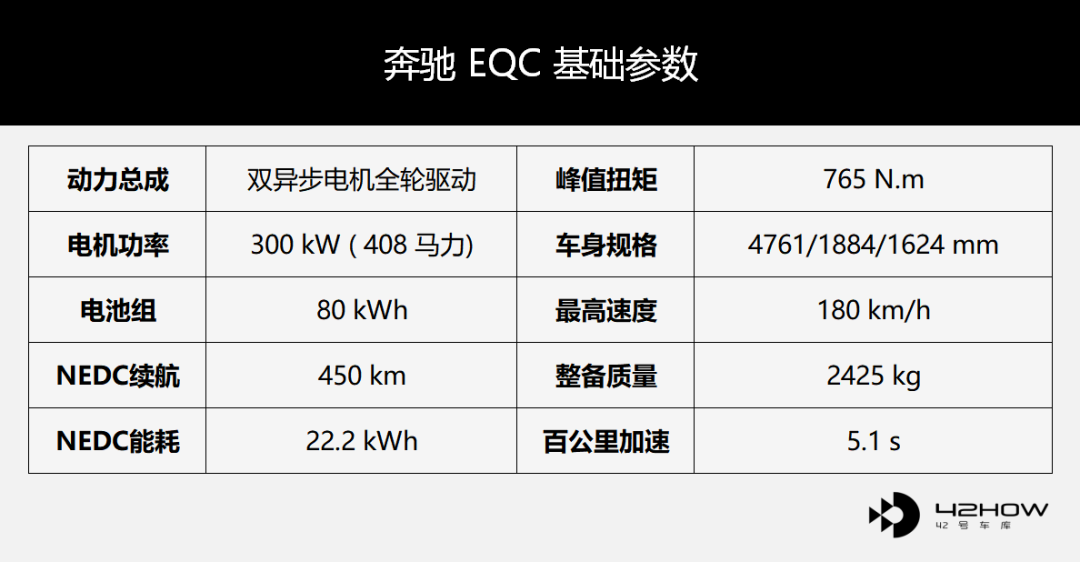
The conclusion can be drawn: despite being much bigger than the EQC, the Tang has a larger battery pack and motors, yet achieves a lighter body, lower energy consumption, faster acceleration, and longer range. In a nutshell, from the point of view of the three power sources, the BYD Tang’s three electric power capabilities comprehensively exceed those of the Mercedes-Benz EQC.
Let’s take a closer look at the data: the energy density of the Tang’s battery pack is 161 Wh/kg. The weight of the EQC’s battery is 650 kg, so its battery pack density is only 123 Wh/kg. The difference is clear.
Originally, this was a very inspiring thing. When the engine of the global automotive industry switched from internal combustion engines and transmissions to motors, controls, and batteries, a group of Chinese new energy cars stood up and said that the Chinese auto industry had a once-in-a-lifetime opportunity, and for the first time, we had reached the starting line for power with traditional automotive industrial powers.
Another group of people argued that traditional automotive giants have long-term layouts and deep technological reserves, and the rise of the Chinese auto industry is nothing more than a pipe dream.
Now it seems that at least from the perspective of the three power sources, Chinese companies are not inferior at all.
However, having good technology is not equal to having everything in place.
If you are a consumer and want to know how far a Tang can travel with a single charge and where to look for it, check out BYD’s official (Weibo ID: BYD Auto) Tang promotional poster below. (Please read it patiently.)

The only sentence related to the range on the poster is: “Moving forward at a constant speed of 60 km/h, it can travel 600 km on a single charge“, which has little reference value compared with the range on the China Automotive Technology & Research Center’s driving cycle test.
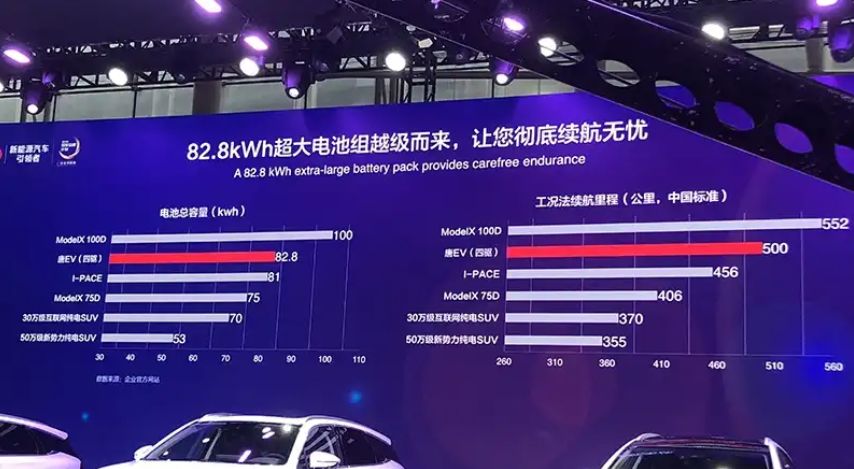
However, at the BYD Tang launch event, BYD announced that the range of the Tang on the NEDC (New European Driving Cycle) test cycle is 500 km (China Standard), while the Model X 75D and 100D have ranges of 406 km and 552 km respectively. It can be confirmed on Tesla’s official website that “the range on the NEDC test cycle” is the China Automotive Technology & Research Center’s driving cycle test.
This causes a bigger issue- the Tang’s battery is 82.8 kWh, which means that if it achieves a range of 500 km on the NEDC cycle, its energy consumption is only 16.56 kWh/100 km.
What level is this? The energy consumption of the Tesla Model 3 is 16.2 kWh/100 km. Is it possible that the energy consumptions of a medium-sized 2.3 ton SUV and a compact 1.7 ton B-class sedan are comparable, regardless of how advanced the technology is? It is impossible to defy the laws of physics like this.
However, it is beyond doubt that the Tang’s battery capacity is 82.8 kWh. If this calculation is correct, the range of the Tang is actually 82.8/17.9 = 463 km, derived from the “industry-leading energy consumption of 17.9 kWh per 100 km” on the poster above.
If you are a potential owner of a BYD Tang, this data is for your reference. On the back of the car’s tail, BYD has attached a badge that reads EV600, which conveys a range of 60 km/h under standardized test conditions, but has no reference value in actual usage.This is a typical process of inferior products driving out superior ones. When BYD first launched the e5 and e6, there was no emphasis on cruising at a constant speed. It is not known which car manufacturer took the lead, perhaps due to the low endurance of early driving conditions, and began to use the data of cruising at a constant speed of 60km/h as a “selling point”. This bad practice quickly spread among domestic and joint venture car companies, and almost all new car companies followed suit.
I cannot help but recall that when the Model S 40 was launched in 2012, an EPA rated cruising range of 224km was truly stretched and there was no emphasis on cruising at a constant speed.
If the Tang only played the game on cruising range, then the Guangzhou Automobile Group Aion S’s approach is even more ruthless.
In our previous article, we briefly introduced the Aion S: it is a sedan developed by Guangzhou Automobile Group based on the second-generation GEP (GAC Electric Platform) pure electric platform, with a wind resistance coefficient of only 0.245, a comprehensive cruising range of about 500km, and a battery pack energy density of 170-180Wh/kg. The car supports OTA, advanced driver assistance systems, and intelligent vehicle systems.
If you do not have a clear understanding of these parameters, an intuitive conclusion is: its level of intelligence and the level of the three-electric technology are not inferior when compared with those that will be on the market next year, nor will it lag behind in comparison.
Of course, the official introduction also includes the sentence “cruising range of 600km at a constant speed of 60km/h”. Considering the fierce competition environment in China, it can also be understood.
However, an article officially released by Guangzhou Automobile Group New Energy yesterday surprised us.

“The wind resistance coefficient of Guangzhou Automobile Group Aion S is 0.245, which is of the same level as the Tesla Model 3.”
In fact, the wind resistance coefficient of the Tesla Model 3 is 0.23 Cd, which is larger than that of the Model S at 0.24 Cd, and the larger Model X is 0.25 Cd. Here we cited the wind resistance of the three models of cars to express that the reduction of the wind resistance coefficient requires a lot of effort from the design and engineering teams to pull apart the small differences after the decimal point. Frankly speaking, Aion S’s wind resistance performance comparing with Model S is already excellent, but Guangzhou Automobile Group still chooses to forcefully bring it down to the level of Model 3 to mislead consumers, which is difficult for us to understand and feel very regrettable.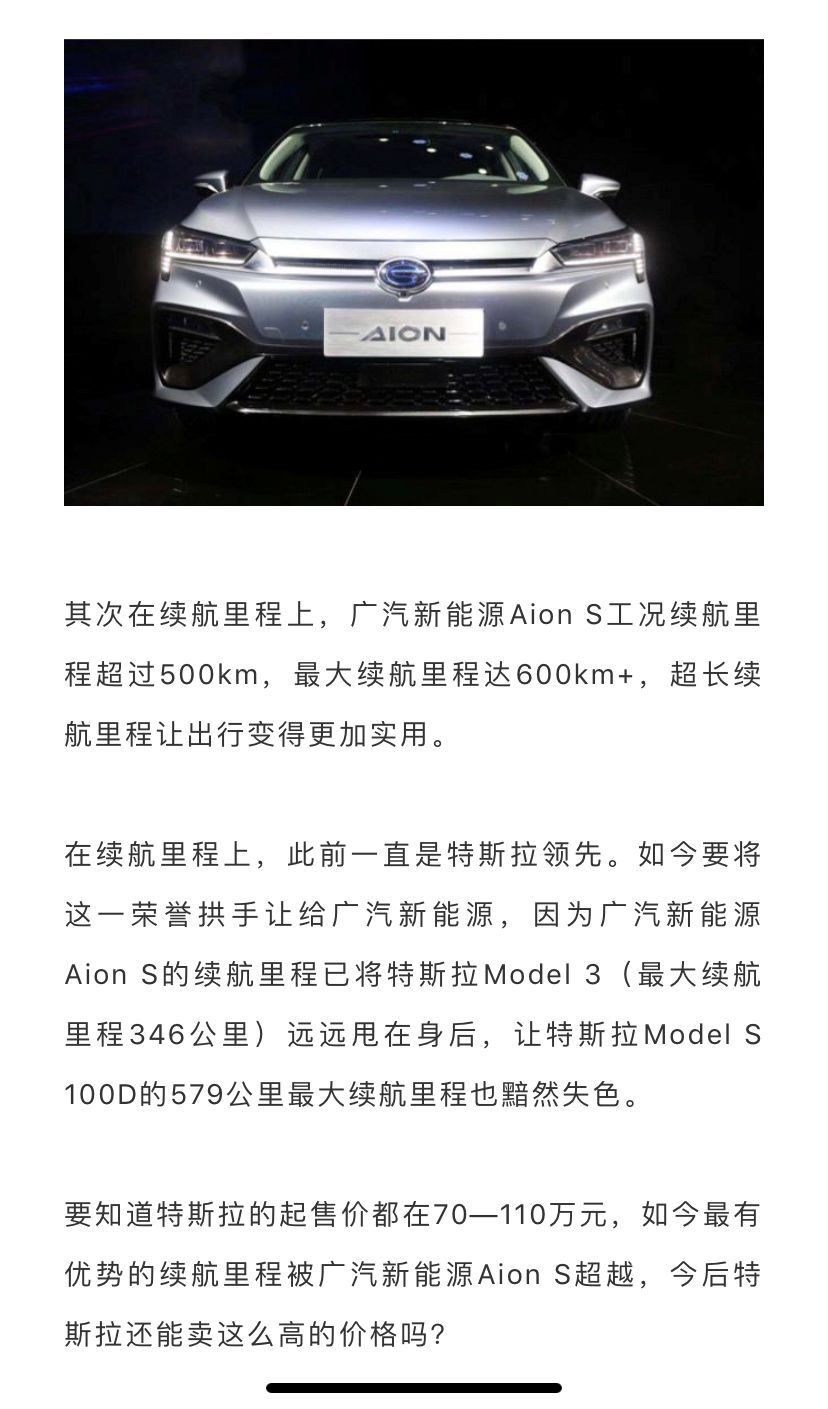
“Previously, Tesla had been leading the way in terms of range. Now, this honor has been handed over to GAC New Energy, as the range of their Aion S far outstrips that of the Tesla Model 3 (maximum range of 346 kilometers), and even eclipses the 579-kilometer maximum range of the Tesla Model S 100D.”
In one sentence, three different test standards were mentioned, the order of which was confusing enough to mislead consumers.
The EPA-rated range of the lowest range version of Model 3 is 354 kilometers (346 kilometers is an error), while the mid-range and long-range versions are rated at 418 kilometers and 499 kilometers respectively. The EPA is the strictest and most everyday-use-like test standard in the world, set by the U.S. Environmental Protection Agency. Moreover, the 579-kilometer range of Tesla Model S 100D is based on the test standard of the Ministry of Industry and Information Technology. However, Aion S’s 600-kilometer range data is based on the constant 60-kilometer-per-hour flat speed range data. One wonders if GAC’s engineers might laugh at this statement.
Even if automakers clearly state the constant speed test conditions in their promotional materials, the user might still misunderstand the range when they see the data of 600 kilometers. And it’s even worse when GAC uses multiple test standards to mislead compared to Tesla and claims to have outdone Tesla.
The so-called “range in excess of 500 kilometers” of Aion S, which is the result of MIIT test conditions, is very similar to the NEDC test standard.
In short, when we put the two tests under the same conditions: Model S 100D has a range of 632 kilometers, and Aion S has a range of 500 kilometers. But in the GAC WeChat article, “Model S fell far behind.”
Now, is 500 km of range for a B-level car like Aion S that bad? No! As we mentioned earlier, it is the level of technology that will not lag behind next year when it goes on sale. So why bother comparing it to the Model S, which is priced at RMB 880,000 and positioned as a luxury car?
It’s hard to accept that when we go to the GAC New Energy website, there is not a word mentioning the range of Aion S under test conditions data. The website only highlights the slogan of “the first pure electric vehicle with a range of more than 600 kilometers.” How does this severe misguidance of consumers on the true level of the product benefit GAC’s brand in the long run?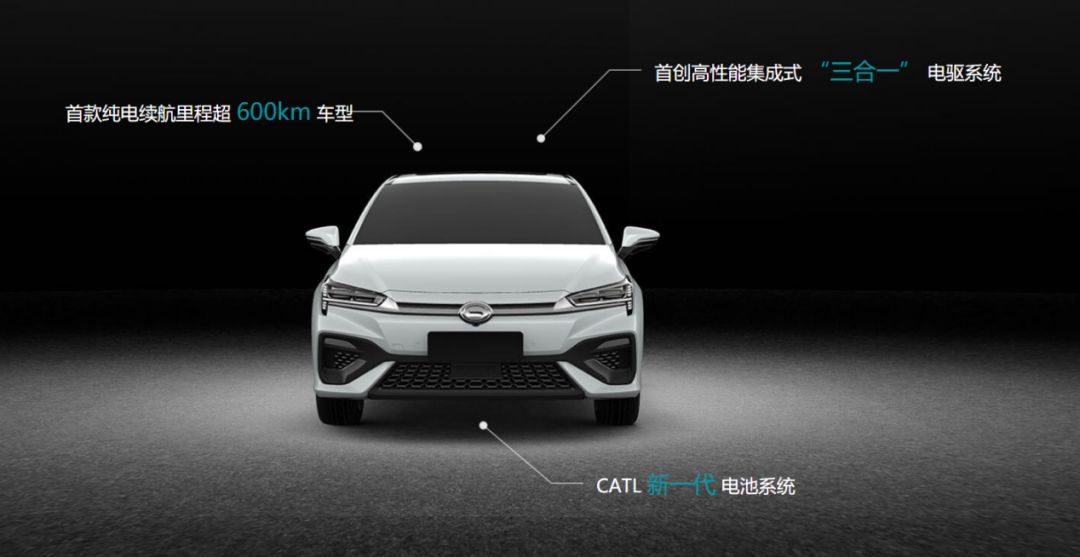
Let’s talk about the Model 3 that was far surpassed by Aion S. The energy density of the battery cell it carries is 268 Wh/kg, and the energy density of its battery pack reaches 187 Wh/kg with a system grouping efficiency of 70%.
So, if we rank the energy density of battery packs, it should be like this:
- Model 3: 187Wh/kg
- BYD Tang: 161Wh/kg
- Aion S: 170-180Wh/kg
- Mercedes-Benz EQC: 123Wh/kg
The fact is that Chinese companies’ technological capabilities are already very advanced, second only to Tesla’s most advanced products, no more than that.
Recently, German Economic Minister Peter Altmaier “challenged” VW Group CEO Herbert Diess, Daimler AG Chairman Dieter Zetsche, and absent BMW Group CEO Harald Krüger at a forum:
I really wonder when you, Mr. Zetsche, or you, Mr. Diess, or Mr. Krüger of BMW will be able to get an electric car build, which is only half as sexy as one by Tesla. As far as the attractiveness of your e-cars is concerned, you could actually come up with some fresh ideas.In the past year, the Tesla-Panasonic alliance has consumed 60% of the world’s power battery capacity. With the enormous scale effect, this alliance has achieved the best battery technology level at the lowest cost. From the Model 3, the gap between Tesla and traditional automakers in the field of vehicle intelligence is getting bigger because the two are striving in different directions.
Whether it is electrification or intelligentization, Chinese automakers are the closest to Tesla, not traditional automotive powers such as Germany, France, Japan, and South Korea. But the difference between us and Germany is that they have strong capital and talent, and are aware of the gap with Tesla, while we believe that we have surpassed Tesla and ranked first in the world, but output meaningless 60km/h cruising range to consumers.
An obvious gap: In October 2016, Tesla began mass production of Model S with a 100kWh battery pack. Three years later, in October 2019, no other automaker in the world can mass produce a pure electric sedan with the same battery specification.
Stop “laughing at Baidu at 50 degrees,” Chinese automakers can only make progress by facing the gap.


This article is a translation by ChatGPT of a Chinese report from 42HOW. If you have any questions about it, please email bd@42how.com.
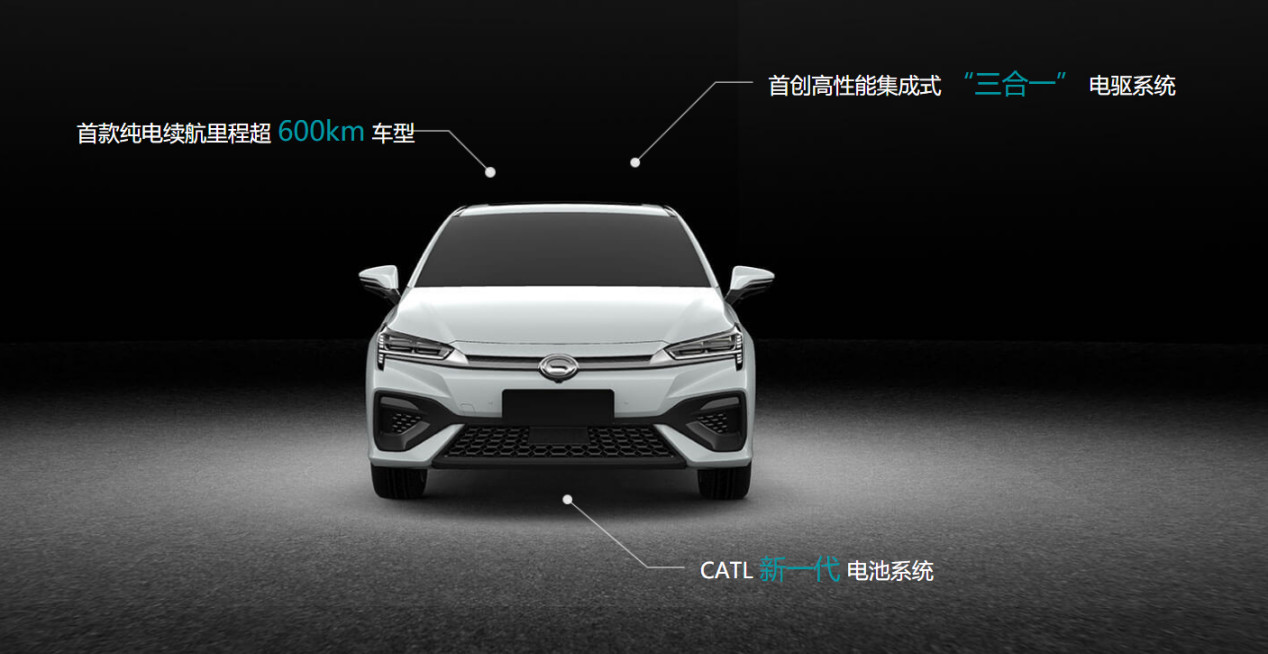
 *
*